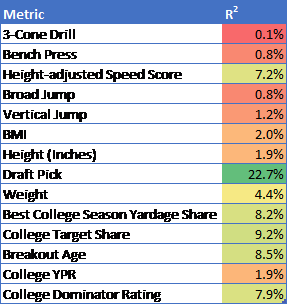Which athleticism and college metrics are the best indicators of fantasy success? What do breakout wide receivers have in common? Using PlayerProfiler’s Data Analysis Tool, we can answer these questions.
Spotting Breakouts
Draft capital is extremely important for wide receivers. After that, age-adjusted college production isn’t just the most important metric, it’s the only one that matters. Aside from maybe Speed Score, athleticism doesn’t matter for wide receivers. Seriously, the Combine drills aside from Speed Score are the last factors to focus on when evaluating wide receiver prospects.
College market share numbers look more predictive of a breakout season than college efficiency, although our ideal prospect will have both. How important is draft capital exactly? There are 55 receivers in the PlayerProfiler database with a breakout season of at least 15 Fantasy Points per Game, which is about what Michael Gallup and DeVante Parker posted last year. Of this group, 20 of 55 (36-percent) were drafted in the first round, 14 of 55 (25-percent) were drafted in the second round, and nine of 55 (16%-percent) were drafted in the third.
What does this mean for 2020?
Almost four out of every five breakout wide receivers were drafted on Day 1 or 2 of the NFL Draft. Considering the immense volume of receivers drafted on Day 3 or signed as UDFAs, finding a breakout pass catcher in that range is like finding a diamond in the rough. We should focus on the higher-probability plays, which are the Day 1 or 2 receivers. For the lauded 2020 wide receiver class, that leaves us with 16 players to work with.
Studs
If you’ve been reading PlayerProfiler and/or listening to The Podfather, there won’t be any surprises here. CeeDee Lamb, Justin Jefferson, Tee Higgins – they all have great profiles based on these metrics.
Brandon Aiyuk, Michael Pittman, and Chase Claypool also performed well in these key stats in addition to receiving strong draft capital. However, research has been done to indicate that non-early declare wide receivers who don’t break out until their senior season have limited chances of success compared to their early declare counterparts. Early declares with strong production profiles such as Laviska Shenault and Tee Higgins should be selected before this group of Aiyuk, Pittman, and Claypool in dynasty rookie drafts.
Laviska Shenault and Jalen Reagor
The two prospects with the best chance of eclipsing CeeDee Lamb to become the WR1 in this class are Laviska Shenault and Jalen Reagor. Of our Day 1 and Day 2 wide receivers, Shenault and Reagor ranked No. 1 and No. 3 respectively in Best College Season Yardage Share. Reagor also ranked No. 1 in the class with a 32.6-percent College Target Share and broke out before turning 19 years-old.
https://www.youtube.com/watch?v=EBMkNPusltc
Factoring in landing spot, both need to be taken before Jerry Jeudy in dynasty.
Duds
Henry Ruggs
Our highest profile bust candidate is easily Henry Ruggs. We know athleticism is largely overrated for wide receivers, and his strong draft capital does not do enough to mask the spotty college production profile. How unlikely would it be for a receiver with Ruggs’s college production to hit? Of our 55 breakout wide receivers with at least one season of 15 Fantasy Points per Game or more, only college quarterback Julian Edelman and college wide receiver/running back Wes Welker posted a lower College Dominator Rating than Ruggs’ 17.5-percent (17th-percentile) mark. Only Edelman, Tyreek Hill and Josh Gordon posted a lower College Target Share than Ruggs’ 14.2-percent (13th-percentile) number. Ruggs also has no Breakout Age, failing to eclipse a 20-percent College Dominator Rating in any college season.
Van Jefferson and Devin Duvernay
It’s tempting to throw a dart on Van Jefferson and/or Devin Duvernay in the back half of dynasty rookie drafts. That’s fine to do as long as we acknowledge that it’s nothing more than a lottery ticket. Statistically, their odds of succeeding are low. Both failed to breakout until their age 22 season. Of our breakout receivers, only Tyreek Hill, Julian Edelman, and Martavis Bryant (who competed for targets in college with Sammy Watkins and DeAndre Hopkins) didn’t manage a season with at least a 20-percent College Dominator Rating by the time they turned 22 years old.
Check out Van Jefferson on PlayerProfiler’s Updated Dynasty Rankings and Projections:
When evaluating wide receiver prospects, don’t be dazzled by the athleticism metrics. Focus on the early-declare wide receivers with strong age-adjusted production and Day 1 or 2 draft capital.




